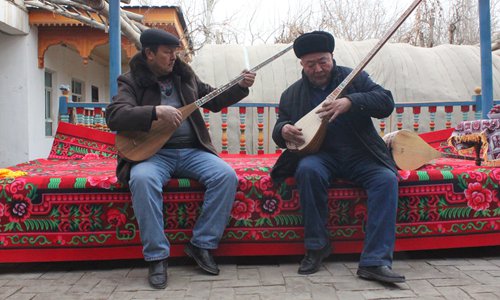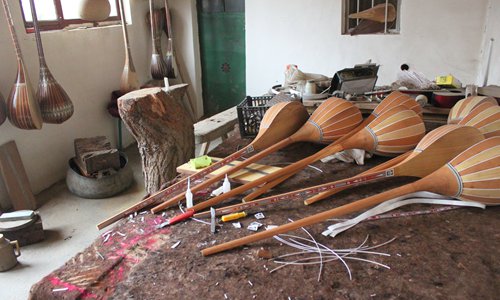
From the People's Daily app.
And this is Story in the Story.
Northwest China's Xinjiang Uygur autonomous region has been a multiethnic region, and in close contact with the Central Plains since ancient times, a recent white paper said.
Ethnic groups entering Xinjiang in different periods brought technology, culture and ideas, folk customs, and many other aspects of their lives into the region, promoting economic and social development through exchanges and integration.
As many cultures in Xinhe County have been identified as intangible heritages, including the craft of making traditional musical instruments, the county government has put forward policies on developing and preserving this heritage.
In May 2014, the county government approved the establishment of an incubation base for developing businesses related to traditional musical instruments for ethnic groups, offering free training and preferential policies to local residents who make musical instruments and work in the tourism industry.
In Xinhe County, craftsmen today receive 150,000 yuan annually in financial support to train apprentices so they can pass traditions on to younger generations.
Today’s Story in the Story looks at how cultural traditions have been preserved in Xinjiang, thanks to poverty alleviation efforts and the skilled craftsmen throughout the region.

Aiyiti (right) plays one of his musical instruments with his apprentice in Aiyiti's house. (Photo: Global Times)
Every time Aiyiti Yiming plays his handmade Dutar, his youngest daughter dances along to the music. It's a scene that always backs memories of Aiyiti playing the instrument with his departed father.
"I learned how to make these musical instruments from my father when I was 15 years old, and he learned the skills from my grandfather. I earn a living from making these instruments, and I love the music," Aiyiti said.
Aiyiti was born in 1954 in Jiayi, Xinhe County in Aksu Prefecture, Northwest China's Xinjiang Uyghur Autonomous Region.
"Jiayi" means "residents living along the road" in Uyghur, as all the houses in this village were built along the main road. One village tale tells of a musician called Shayifu Banlihe. Hundreds of birds would fly around him when he played his instrument, and passers-by would also be mesmerized by his music.
Aside from government support, many fans of traditional Xinjiang music also devoted themselves to the protection of the art form.
In recent years, the regional government has cultivated festivals featuring ethnic music and dance and also taken measures to promote innovative ethnic music to attract a wider audience.
There are more than 106 households in the village that make musical instruments of ethnic groups, including the Dutar, Surnay, Qushtar, Tambur, Rawab, and Dombra.
Because of his skill, Aiyiti stood out among them. He was named an inheritor of intangible cultural heritage for making musical instruments of ethnic groups in Xinjiang in 2008 and has trained more than 80 apprentices in Xinhe County.
Visitors to Aiyiti's house can see two rooms that have been converted into workshops, one for making musical instruments and one for displaying the completed ones. In one workshop, there are piles of wood and half-finished instrument parts, some resembling a large spoon.

Half-completed Dutars in Aiyiti's workshop (Photo: Global Times)
Aiyiti pointed to one of the spoon-like pieces of wood and explained, "This is the Dutar, which is made of mulberry wood. We need to use a special chisel to make the wood into an oval-like shape on one side and make the other side hollow."
The other parts of the Dutar include crooked wooden chips that cover the outside of the oval-like body, a long "handle" for the strings, and ornamental decorations for the musical instrument.
"It takes dozens of days to complete a Dutar. Take the one which I sell for 30,000 yuan ($4,472), for example. The ornaments on it were made of high-quality ram's horn and snakeskin. It takes a year to finish making three such Dutar," Aiyiti said.
It used to take a longer time to make one instrument, as materials were hard to find. "The strings of the Dutar were made of ram's intestines. I bought intestines and put them into salty water for about three days. And then by using a stick with two holes on each side, I stretched them again and again to make it as thin and soft as it needed to be," Aiyiti said.
Thanks to industrial advances, there is now no need to go to such lengths to produce strings. Aiyiti said that he can now buy the different strings he needs from markets that can guarantee their quality.
But he insists on making the other parts of different musical instruments by hand, and asks all his apprentices to do the same. "Making musical instruments is a craft that needs to be carried forward to the next generation," he said.
Aiyiti said that his wish for the future is to do his best to train good apprentices and pass his skills to the next generation.
"With the full support of different parties in society, I hope more people can learn the beauty of making and playing the musical instruments of different ethnic groups," he said.
(Produced by Nancy Yan Xu, Lance Crayon, Brian Lowe and Paris Yelu Xu. Music by: bensound.com. Text from Global Times and China Daily.)


